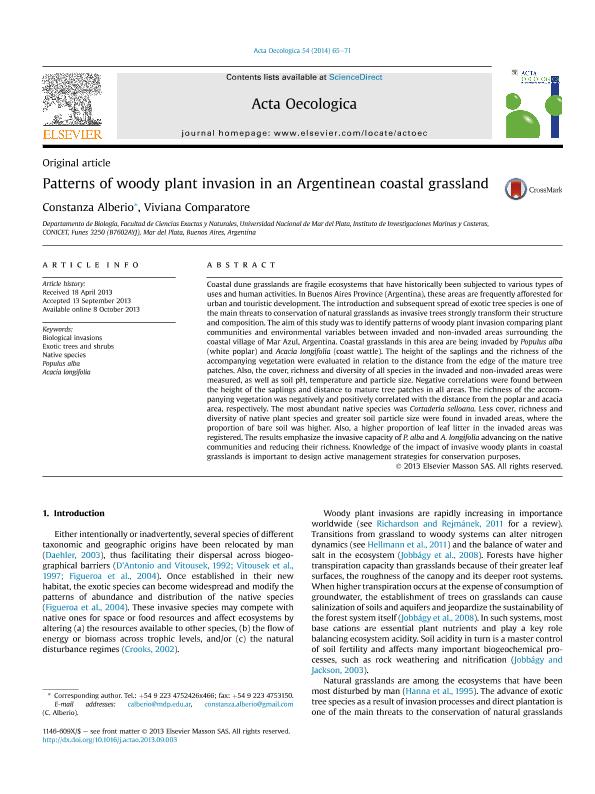Mostrar el registro sencillo del ítem
dc.contributor.author
Alberio, Constanza

dc.contributor.author
Comparatore, Viviana
dc.date.available
2017-09-29T19:38:33Z
dc.date.issued
2013-10
dc.identifier.citation
Alberio, Constanza; Comparatore, Viviana; Patterns of woody plant invasion in an Argentinean coastal grassland; Elsevier Masson; Acta Oecologica; 54; 10-2013; 65-71
dc.identifier.issn
1146-609X
dc.identifier.uri
http://hdl.handle.net/11336/25476
dc.description.abstract
Coastal dune grasslands are fragile ecosystems that have historically been subjected to various types of uses and human activities. In Buenos Aires Province (Argentina), these areas are frequently afforested for urban and touristic development. The introduction and subsequent spread of exotic tree species is one of the main threats to conservation of natural grasslands as invasive trees strongly transform their structure and composition. The aim of this study was to identify patterns of woody plant invasion comparing plant communities and environmental variables between invaded and non-invaded areas surrounding the coastal village of Mar Azul, Argentina. Coastal grasslands in this area are being invaded by Populus alba (white poplar) and Acacia longifolia (coast wattle). The height of the saplings and the richness of the accompanying vegetation were evaluated in relation to the distance from the edge of the mature tree patches. Also, the cover, richness and diversity of all species in the invaded and non-invaded areas were measured, as well as soil pH, temperature and particle size. Negative correlations were found between the height of the saplings and distance to mature tree patches in all areas. The richness of the accompanying vegetation was negatively and positively correlated with the distance from the poplar and acacia area, respectively. The most abundant native species was Cortaderia selloana. Less cover, richness and diversity of native plant species and greater soil particle size were found in invaded areas, where the proportion of bare soil was higher. Also, a higher proportion of leaf litter in the invaded areas was registered. The results emphasize the invasive capacity of P. alba and A. longifolia advancing on the native communities and reducing their richness. Knowledge of the impact of invasive woody plants in coastal grasslands is important to design active management strategies for conservation purposes.
dc.format
application/pdf
dc.language.iso
eng
dc.publisher
Elsevier Masson

dc.rights
info:eu-repo/semantics/openAccess
dc.rights.uri
https://creativecommons.org/licenses/by-nc-sa/2.5/ar/
dc.subject
Biological Invasions
dc.subject
Exotic Trees And Shrubs
dc.subject
Native Species
dc.subject
Populus Alba
dc.subject
Acacia Longifolia
dc.subject.classification
Bioquímica y Biología Molecular

dc.subject.classification
Ciencias Biológicas

dc.subject.classification
CIENCIAS NATURALES Y EXACTAS

dc.title
Patterns of woody plant invasion in an Argentinean coastal grassland
dc.type
info:eu-repo/semantics/article
dc.type
info:ar-repo/semantics/artículo
dc.type
info:eu-repo/semantics/publishedVersion
dc.date.updated
2017-09-27T15:35:53Z
dc.journal.volume
54
dc.journal.pagination
65-71
dc.journal.pais
Francia

dc.journal.ciudad
Paris
dc.description.fil
Fil: Alberio, Constanza. Consejo Nacional de Investigaciones Científicas y Técnicas. Centro Científico Tecnológico Conicet - Mar del Plata. Instituto de Investigaciones Marinas y Costeras. Universidad Nacional de Mar del Plata. Facultad de Ciencia Exactas y Naturales. Instituto de Investigaciones Marinas y Costeras; Argentina
dc.description.fil
Fil: Comparatore, Viviana. Consejo Nacional de Investigaciones Científicas y Técnicas. Centro Científico Tecnológico Conicet - Mar del Plata. Instituto de Investigaciones Marinas y Costeras. Universidad Nacional de Mar del Plata. Facultad de Ciencia Exactas y Naturales. Instituto de Investigaciones Marinas y Costeras; Argentina
dc.journal.title
Acta Oecologica
dc.relation.alternativeid
info:eu-repo/semantics/altIdentifier/doi/http://dx.doi.org/10.1016/j.actao.2013.09.003
dc.relation.alternativeid
info:eu-repo/semantics/altIdentifier/url/http://www.sciencedirect.com/science/article/pii/S1146609X13001434
Archivos asociados
